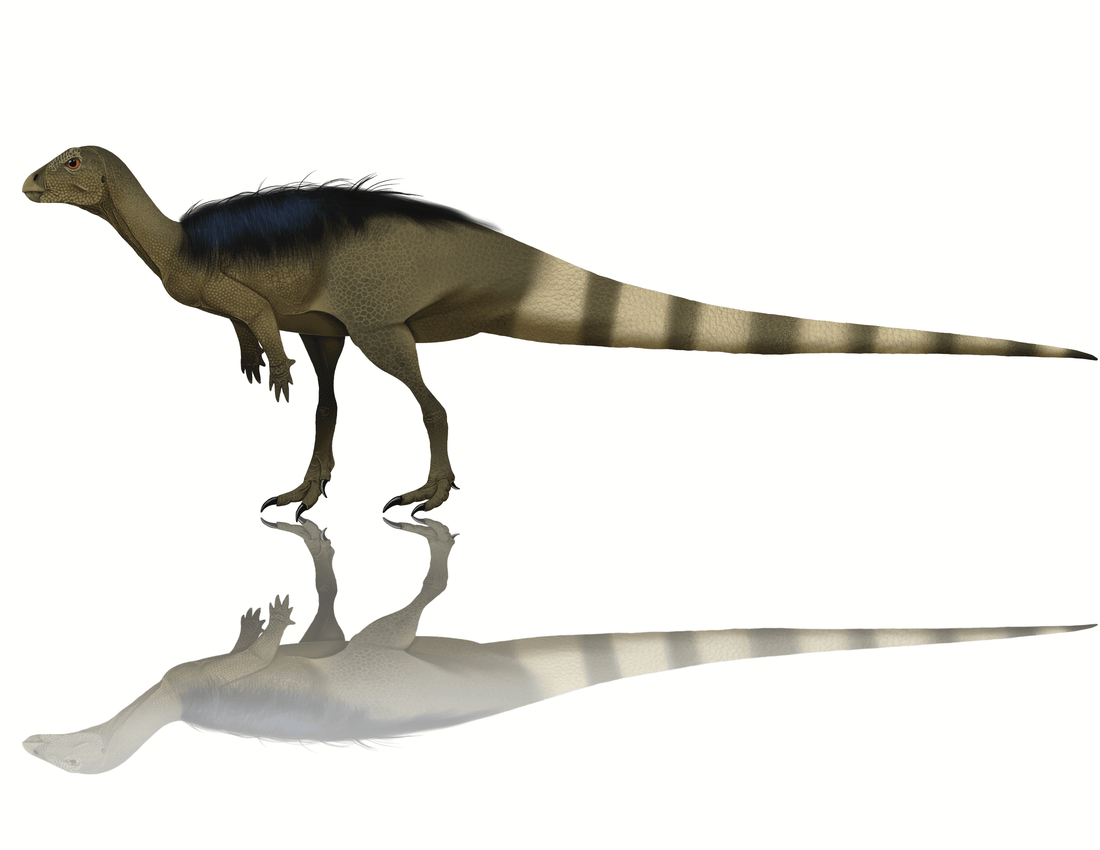Ubirajara jubatus, the "Maned Lord of the Spear," is a beautifully preserved 3' long, ~112 million-year-old meat-eating Brazilian dinosaur. The specimen is preserved with a proto-feathery mane down its spine and on its arms and hands. The mane likely was not "puffed up" all the time, but rather could be "flexed" by muscles in the skin to make it appear more fearsome, possibly more attractive when looking for mates, and maybe helped with thermoregulation, all things birds do with their feathers today.
The specimen was also found with two 6" long structures the authors called "broad monofilamentous integuments" (BMFI), which they interpreted as thick proto-feathers used for display. Here is where, to me, it is important to indicate what is known versus what is hypothesized. Only two of these structures were found, not four. They logically concluded the structures would be paired, meaning the animal would have had 4 in total. However, the structures are not observed attaching to the animal. A layer of adipocere (a substance that results from decomposing soft tissue) obscures the end of the BMF that would attach to the body. Lacking a definitive attachment point, the authors logically followed the line these BMFIs would make if they were attached to the body, which resulted in the hypothesis they originated on the left shoulder. They considered the possibility these structures originate from the side or the chest, and suggested it is possible they could have come from the forelimb and were simply displaced. What they do not discuss is the possibility these ribbons were not part of this specimen at all, that they floated in during fossilization. I am reminded of Charles Marsh describing the first specimen of Pteranodon, he called it Pterodactylus and ascribed to it a tooth that had been found among the remains. This tooth, as it turns out, actually belonged to a fish called Xiphactinus, but because all pterosaurs to that point had been found with teeth, he wasn't at all surprised it had been found with a tooth. It took additional specimens for him to learn Pteranodon lacked teeth. I don't mean to disparage the paper's work but I do wish they had explored more the possibility that these structures do not belong to this specimen. To reiterate, the authors do not have evidence the BMFIs actually attach to the animal, nor do they have evidence for more than 2 structures.
They suggest the BMFIs found on Beipiaosaurus (a therizinosaur) and Yutyrannus (a large tyrannosaur) are similar to those of Ubirajara and indicate the BMFIs would have been used for display, citing the standardwing bird-of-paradise as an example of the possible use of the 4 ribbons. They point out that the length of the BMFIs in Ubirajara are similar in absolute size to those of the other two aforementioned dinosaurs; however, those two are much, much larger than the tiny Ubirajara.
On the standardwing bird-of-paradise, 2 long feathers (called carpal standards) attach to each wrist and are used in mating dances (videos here and here), where they vigorously move their wings, and the ribbons flutter back and forth, sometimes so fast they make a cracking sound. A key takeaway to me is the ribbons are to attract mates. However, the Ubirajara specimen is a juvenile or sub-adult, as evidenced by several skeletal characteristics such as open neuro-central sutures. It would be extremely odd should a juvenile have elaborate mating structures before they are needed.
Fun Facts:
The Ubirajara specimen was found with the keratinous sheath on its claws fully intact. The sheath adds an additional 40% in length to the claw and they make the claw much more recurved (and sharper) than the bone core alone would indicate. If these characters scale as the animal grows, it suggests many dinosaur claws are longer, and more curved, than previously believed.
It is likely Ubirajara, and probably most dinosaurs shed their skin dandruff-style like mammals and birds, and not reptile-style with large chunks of flesh coming off at once, thanks to having corneocytes. Though the skin is similar to birds, the small dinosaurs lack the fat layer present in flying birds that helps keep them warm at high, cold altitudes.

